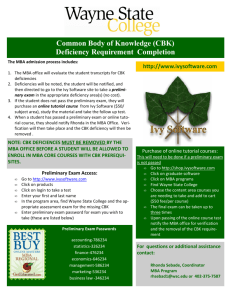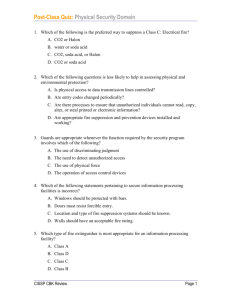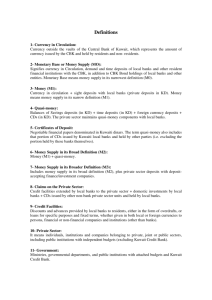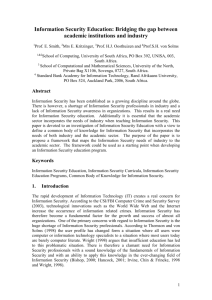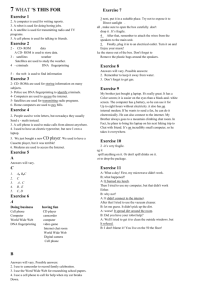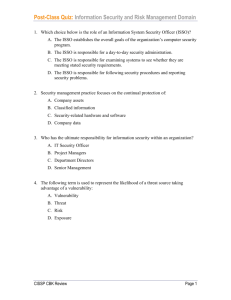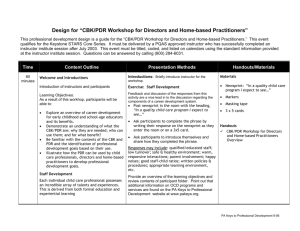Domain 2 - Telecommunication and Network Security
advertisement
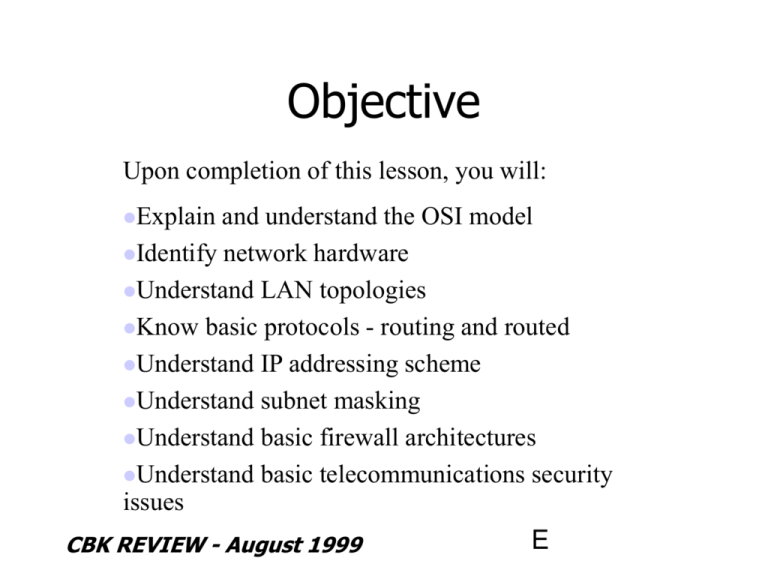
Objective Upon completion of this lesson, you will: Explain and understand the OSI model Identify network hardware Understand LAN topologies Know basic protocols - routing and routed Understand IP addressing scheme Understand subnet masking Understand basic firewall architectures Understand basic telecommunications security issues CBK REVIEW - August 1999 E Course Outline • Intro to OSI model • LAN topologies • OSI revisited – hardware – bridging,routing – routed protocols, WANs • IP addressing, subnet masks • Routing Protocols CBK REVIEW - August 1999 E OSI/ISO ?? • OSI model developed by ISO, International Standards Organization • IEEE - Institute of Electrical and Electronics Engineers • NSA - National Security Agency • NIST - National Institute for Standards and Technology • ANSI - American National Standards Institute • CCITT - International Telegraph and Telephone Consultative Committee CBK REVIEW - August 1999 E OSI Reference Model Open Systems Interconnection Reference Model Standard model for network communications Allows dissimilar networks to communicate Defines 7 protocol layers (a.k.a. protocol stack) Each layer on one workstation communicates with its respective layer on another workstation using protocols (i.e. agreed-upon communication formats) “Mapping” each protocol to the model is useful for comparing protocols. CBK REVIEW - August 1999 E OSI MODEL DIAGRAM Developed by the International Standards Organization 7 Application Provides specific services for applications such as file transfer 6 Presentation Provides data representation between systems 5 Session Establishes, maintains, manages sessions example - synchronization of data flow 4 Transport Provides end-to-end data transmission integrity 3 Network Switches and routes information units 2 Data Link Provides transfer of units of information to other end of physical link 1 Physical Transmits bit stream on physical medium Mnemonic: All People Seem To Need Data Processing CBK REVIEW - August 1999 E OSI Reference Model Data Flow CLIENT 5 Session 4 Transport 3 Network 2 Data Link 1 Physical Then up the receiving stack 6 Presentation Data travels down the stack 7 Application SERVER 7 Application 6 Presentation 5 Session 4 Transport 3 Network 2 Data Link 1 Physical Through the network As the data passes through each layer on the client information about that layer is added to the data.. This information is stripped off by the corresponding layer on the server. CBK REVIEW - August 1999 E OSI Model • Everything networked is covered by OSI model • Keep model in mind for rest of course • All layers to be explored in more detail CBK REVIEW - August 1999 E SECTION • LAN TOPOLOGIES – Physical Layer • EXAMPLE TYPES CBK REVIEW - August 1999 E LAN Topologies • Star • Bus • Tree • Ring CBK REVIEW - August 1999 E Star Topology • Telephone wiring is one common example – Center of star is the wire closet • Star Topology easily maintainable CBK REVIEW - August 1999 E Bus Topology • Basically a cable that attaches many devices • Can be a “daisy chain” configuration • Computer I/O bus is example CBK REVIEW - August 1999 E Tree Topology • Can be extension of bus and star topologies • Tree has no closed loops CBK REVIEW - August 1999 E Ring Topology • Continuous closed path between devices • A logical ring is usually a physical star • Don’t confuse logical and physical topology MAU CBK REVIEW - August 1999 E Network topologies Topology Bus Star Ring Advantages Passive transmission medium Localized failure impact Adaptive Utilization Simplicity Central routing No routing decisions Simplicity Predictable delay No routing decisions CBK REVIEW - August 1999 Disadvantages Channel access technique (contention) Reliability of central node Loading of central node Failure modes with global effect E LAN Access Methods • Carrier Sense Multiple Access with Collision Detection (CSMA/CD) – Talk when no one else is talking • Token – Talk when you have the token • Slotted – Similar to token, talk in free “slots” CBK REVIEW - August 1999 E LAN Signaling Types • Baseband – Digital signal, serial bit stream • Broadband – Analog signal – Cable TV technology CBK REVIEW - August 1999 E LAN Topologies • • • • Ethernet Token Bus Token Ring FDDI CBK REVIEW - August 1999 E Ethernet • • • • • • Bus topology CSMA/CD Baseband Most common network type IEEE 802.3 Broadcast technology - transmission stops at terminators CBK REVIEW - August 1999 E Token Bus • • • • IEEE 802.4 Very large scale, expensive Usually seen in factory automation Used when one needs: – Multichannel capabilities of a broadband LAN – resistance to electrical interference CBK REVIEW - August 1999 E Token Ring • IEEE 802.5 • Flow is unidirectional • Each node regenerates signal (acts as repeater) • Control passed from interface to interface by “token” • Only one node at a time can have token • 4 or 16 Mbps CBK REVIEW - August 1999 E Fiber Distributed Data Interface (FDDI) • Dual counter rotating rings – Devices can attach to one or both rings – Single attachment station (SAS), dual (DAS) • Uses token passing • Logically and physically a ring • ANSI governed CBK REVIEW - August 1999 E WANs • WANs connect LANs • Generally a single data link • Links most often come from Regional Bell Operating Companies (RBOCs) or Post, Telephone, and Telegraph (PTT) agencies • Wan link contains Data Terminal Equipment (DTE) on user side and Data CircuitTerminating Equipment (DCE) at WAN provider’s end • MAN - Metropolitan CBK REVIEW - August 1999Area NetworkE OSI Model Revisited • Physical • • • • • • Data Link Network Transport Session Presentation Application CBK REVIEW - August 1999 E Physical Layer • Specifies the electrical, mechanical, procedural, and functional requirements for activating, maintaining, and deactivating the physical link between end systems • Examples of physical link characteristics include voltage levels, data rates, maximum transmission distances, and physical connectors E CBK REVIEW - August 1999 Physical Layer Hardware • Cabling – – – – – twisted pair 10baseT 10base2 10base5 fiber • transceivers • hubs • topology CBK REVIEW - August 1999 E Twisted Pair • 10BaseT (10 Mbps, 100 meters w/o repeater) • Unshielded and shielded twisted pair (UTP most common) • two wires per pair, twisted in spiral • Typically 1 to 10 Mbps, up to 100Mbps possible • Noise immunity and emanations improved by shielding CBK REVIEW - August 1999 E Coaxial Cable • • • • • • 10Base2 (10 Mbps, repeater every 200 m) ThinEthernet or Thinnet or Coax 2-50 Mbps Needs repeaters every 200-500 meters Terminator: 50 ohms for ethernet, 75 for TV Flexible and rigid available, flexible most common • Noise immunity and emanations very good CBK REVIEW - August 1999 E Coaxial Cables, cont • Ethernet uses “T” connectors and 50 ohm terminators • Every segment must have exactly 2 terminators • Segments may be linked using repeaters, hubs CBK REVIEW - August 1999 E Standard Ethernet • 10Base5 • Max of 100 taps per segment • Nonintrusive taps available (vampire tap) • Uses AUI (Attachment Unit Interface) CBK REVIEW - August 1999 E Fiber-Optic Cable • Consists of Outer jacket, cladding of glass, and core of glass • fast CBK REVIEW - August 1999 E Transceivers • Physical devices to allow you to connect different transmission media • May include Signal Quality Error (SQE) or “heartbeat” to test collision detection mechanism on each transmission • May include “link light”, lit when connection exists CBK REVIEW - August 1999 E Hubs • A device which connects several other devices • Also called concentrator, repeater, or multi-station access unit (MAU) CBK REVIEW - August 1999 E OSI Model Revisited • Physical • Data Link • • • • • Network Transport Session Presentation Application CBK REVIEW - August 1999 E Data Link Layer • Provides data transport across a physical link • Data Link layer handles physical addressing, network topology, line discipline, error notification, orderly delivery of frames, and optional flow control • Bridges operate at this layer CBK REVIEW - August 1999 E Data Link Sublayers • Media Access Control (MAC) – refers downward to lower layer hardware functions • Logical Link Control (LLC) – refers upward to higher layer software functions CBK REVIEW - August 1999 E Medium Access Control (Data Link Sublayer) • MAC address is “physical address”, unique for LAN interface card – Also called hardware or link-layer address • The MAC address is burned into the Read Only Memory (ROM) • MAC address is 48 bit address in 12 hexadecimal digits – 1st six identify vendor, provided by IEEE – 2nd six unique, provided by vendor CBK REVIEW - August 1999 E Logical Link Control (Data Link Sublayer) • Presents a uniform interface to upper layers • Enables upper layers to gain independence over LAN media access – upper layers use network addresses rather than MAC addresses • Provide optional connection, flow control, and sequencing services CBK REVIEW - August 1999 E Bridges (Data Link Layer) • Device which forwards frames between data link layers associated with two separate cables • Stores source and destination addresses in table • When bridge receives a frame it attempts to find the destination address in its table – If found, frame is forwarded out appropriate port – If not found, frame is flooded on all other ports CBK REVIEW - August 1999 E Bridges (Data Link Layer) • Can be used for filtering – Make decisions based on source and destination address, type, or combination thereof • Filtering done for security or network management reasons – Limit bandwidth hogs – Prevent sensitive data from leaving • Bridges can be for local or remote networks – Remote has “half” at each end of WAN link CBK REVIEW - August 1999 E Network Layer • Which path should traffic take through networks? • How do the packets know where to go? • What are protocols? • What is the difference between routed and routing protocols? CBK REVIEW - August 1999 E Network Layer • Name - what something is – example is SSN • Address - where something is • Route - how to get there – Depends on source CBK REVIEW - August 1999 E Network Layer • Only two devices which are directly connected by the same “wire” can exchange data directly • Devices not on the same network must communicate via intermediate system • Router is an intermediate system • The network layer determines the best way to transfer data. It manages device addressing and tracks the location of devices. The router operates at this layer. CBK REVIEW - August 1999 E Network Layer Bridge vs. Router • Bridges can only extend a single network – All devices appear to be on same “wire” – Network has finite size, dependent on topology, protocols used • Routers can connect bridged subnetworks • Routed network has no limit on size – Internet, SIPRNET CBK REVIEW - August 1999 E Network Layer • Provides routing and relaying – Routing: determining the path between two end systems – Relaying: moving data along that path • Addressing mechanism is required • Flow control may be required • Must handle specific features of subnetwork – Mapping between data link layer and network layer addresses CBK REVIEW - August 1999 E Connection-Oriented vs. Connectionless Network Layer • Connection-Oriented – provides a Virtual Circuit (VC) between two end systems (like a telephone) – 3 phases - call setup, data exchange, call close – Examples include X.25, OSI CONP, IBM SNA – Ideal for traditional terminal-host networks of finite size CBK REVIEW - August 1999 E Connection-Oriented vs. Connectionless Network Layer • Connectionless (CL) – Each piece of data independently routed – Sometimes called “datagram” networking – Each piece of data must carry all addressing and routing info – Basis of many current LAN/WAN operations • TCP/IP, OSI CLNP, IPX/SPX – Well suited to client/server and other distributed system networks CBK REVIEW - August 1999 E Connection-Oriented vs. Connectionless Network Layer • Arguments can be made Connection Oriented is best for many applications • Market has decided on CL networking – All mainstream developments on CL – Majority of networks now built CL – Easier to extend LAN based networks using CL WANs • We will focus on CL CBK REVIEW - August 1999 E Network switching Circuit-switched Transparent path between devices Dedicated circuit Phone call Packet-switched Data is segmented, buffered, & recombined CBK REVIEW - August 1999 E Network Layer Addressing • Impossible to use MAC addresses • Hierarchical scheme makes much more sense (Think postal - city, state, country) • This means routers only need to know regions (domains), not individual computers • The network address identifies the network and the host CBK REVIEW - August 1999 E Network Layer Addressing • Network Address - path part used by router • Host Address - specific port or device 1.1 1.2 1.3 Router 2.1 2.2 Network Host 1 1,2,3 2 CBK REVIEW - August 1999 1,2,3 2.3 E Network Layer Addressing IP example IP addresses are like street addresses for computers Networks are hierarchically divided into subnets called domains Domains are assigned IP addresses and names – Domains are represented by the network portion of the address IP addresses and Domains are issued by InterNIC (cooperative activity between the National Science Foundation, Network Solutions, Inc. and AT&T) CBK REVIEW - August 1999 E Network Layer Addressing IP • IP uses a 4 octet (32 bit) network address • The network and host portions of the address can vary in size • Normally, the network is assigned a class according to the size of the network – – – – Class Class Class Class A uses 1 octet for the network B uses 2 octets for the network C uses 3 octets for the network D is used for multicast addresses CBK REVIEW - August 1999 E Class A Address Used in an inter-network that has a few networks and a large number of hosts First octet assigned, users designate the other 3 octets (24 bits) Up to 128 Class A Domains Up to 16,777,216 hosts per domain 24 Bits of Variable Address This Field is Fixed by IAB 0-127 0-255 CBK REVIEW - August 1999 0-255 0-255 E Class B Address Used for a number of networks having a number of hosts First 2 octets assigned, user designates the other 2 octets (16 bits) 16384 Class B Domains Up to 65536 hosts per domain These Fields are Fixed by IAB 128-191 16 Bits of Variable Address 0-255 CBK REVIEW - August 1999 0-255 0-255 E Class C Address Used for networks having a small amount of hosts First 3 octets assigned, user designates last octet (8 bits) Up to 2,097,152 Class C Domains Up to 256 hosts per domain 8 Bits of Variable Address These Fields are Fixed by IAB 191-223 0-255 CBK REVIEW - August 1999 0-255 0-255 E IP Addresses • A host address of all ones is a broadcast • A host address of zero means the wire itself • These host addresses are always reserved and can never be used CBK REVIEW - August 1999 E Subnets & Subnet Masks Every host on a network (i.e. same cable segment) must be configured with the same subnet ID. First octet on class A addresses First & second octet on class B addresses First, second, & third octet on class C addresses A Subnet Mask (Netmask) is a bit pattern that defines which portion of the 32 bits represents a subnet address. Network devices use subnet masks to identify which part of the address is network and which part is host E CBK REVIEW - August 1999 Network Layer Routed vs. Routing Protocols • Routed Protocol - any protocol which provides enough information in its network layer address to allow the packet to reach its destination • Routing Protocol - any protocol used by routers to share routing information CBK REVIEW - August 1999 E Routed Protocols • • • • • IP IPX SMB Appletalk DEC/LAT CBK REVIEW - August 1999 E OSI Reference Model Protocol Mapping TCP/IP 7 Application Application using TCP/IP UDP/IP SPX/IPX Application using UDP/IP Application using SPX/IPX 6 Presentation SPX 5 Session 4 Transport TCP UDP 3 Network IP IP IPX 2 Data Link 1 Physical CBK REVIEW - August 1999 E Network-level Protocols IPX (Internet Packet Exchange protocol) Novell Netware & others Works with the Session-layer protocol SPX (Sequential Packet Exchange Protocol) NETBEUI (NetBIOS Extended User Interface) Windows for Workgroups & Windows NT IP (Internet Protocol) Win NT, Win 95, Unix, etc… Works with the Transport-layer protocols TCP (Transmission Control Protocol) and UDP (User Datagram Protocol) SLIP (Serial-line Input Protocol) & PPP (Point-toPoint Protocol) CBK REVIEW - August 1999 E TCP/IP Consists of a suite of protocols (TCP & IP) Handles data in the form of packets Keeps track of packets which can be Out of order Damaged Lost Provides universal connectivity reliable full duplex stream delivery (as opposed to the unreliable UDP/IP protocol suite used by such applications as PING and DNS) CBK REVIEW - August 1999 E TCP/IP (cont') Primary Services (applications) using TCP/IP File Transfer (FTP) Remote Login (Telnet) Electronic Mail (SMTP) Currently the most widely used protocol (especially on the Internet) Uses the IP address scheme CBK REVIEW - August 1999 E Routing Protocols • Vector-distancing – List of destination networks with direction and distance in hops • Link-state routing – Topology map of network identifies all routers and subnetworks – Route is determined from shortest path to destination • Routes can be manually loaded (static) or dynamically maintained CBK REVIEW - August 1999 E Routing Internet Management Domains • Core of Internet uses Gateway-Gateway Protocol (GGP) to exchange data between routers • Exterior Gateway Protocol (EGP) is used to exchange routing data with core and other autonomous systems • Interior Gateway Protocol (IGP) is used within autonomous systems CBK REVIEW - August 1999 E Routing Internet Management Domains Internet Core GGP EGP EGP IGP IGP Autonomous systems CBK REVIEW - August 1999 E Routing Protocols • Static routes – not a protocol – entered by hand – define a path to a network or subnet – Most secure CBK REVIEW - August 1999 E Routing Protocols RIP • Distance Vector • Interior Gateway Protocol • Noisy, not the most efficient – Broadcast routes every 30 seconds – Lowest cost route always best – A cost of 16 is unreachable • No security, anyone can pretend to be a router CBK REVIEW - August 1999 E Routing Protocols OSPF • • • • Link-state Interior Gateway Protocol Routers elect “Designated Router” All routers establish a topology database using DR as gateway between areas • Along with IGRP, a replacement for outdated RIP CBK REVIEW - August 1999 E Routing Protocols BGP • Border Gateway Protocol is an EGP • Can support multiple paths between autonomous systems • Can detect and suppress routing loops • Lacks security • Internet recently down because of incorrectly configured BGP on ISP router CBK REVIEW - August 1999 E Source Routing • Source (packet sender) can specify route a packet will traverse the network • Two types, strict and loose • Allows IP spoofing attacks • Rarely allowed across Internet CBK REVIEW - August 1999 E Transport Layer • • • • TCP UDP IPX Service Advertising Protocol Are UDP and TCP connectionless or connection oriented? • What is IP? • Explain the difference CBK REVIEW - August 1999 E Session Layer • Establishes, manages and terminates sessions between applications – coordinates service requests and responses that occur when applications communicate between different hosts • Examples include: NFS, RPC, X Window System, AppleTalk Session Protocol CBK REVIEW - August 1999 E Presentation Layer • Provides code formatting and conversion • For example, translates between differing text and data character representations such as EBCDIC and ASCII • Also includes data encryption • Layer 6 standards include JPEG, GIF, MPEG, MIDI CBK REVIEW - August 1999 E Application-level Protocols FTP (File Transfer Protocol) TFTP (Trivial File Transfer Protocol) Used by some X-Terminal systems HTTP (HyperText Transfer Protocol) SNMP (Simple Network Management Protocol Helps network managers locate and correct problems in a TCP/IP network Used to gain information from network devices such as count of packets received and routing tables SMTP (Simple Mail Transfer Protocol) Used by many email applications CBK REVIEW - August 1999 E Identification & Authentication • Identify who is connecting - userid • Authenticate who is connecting – password (static) - something you know – token (SecureID) - something you have – biometric - something you are – RADIUS, TACACS, PAP, CHAP CBK REVIEW - August 1999 E Firewall Terms Network address translation (NAT) Internal addresses unreachable from external network DMZ - De-Militarized Zone Hosts that are directly reachable from untrusted networks ACL - Access Control List can be router or firewall term CBK REVIEW - August 1999 E Firewall Terms • Choke, Choke router – A router with packet filtering rules (ACLs) enabled • Gate, Bastion host, Dual Homed Host – A server that provides packet filtering and/or proxy services • proxy server – A server that provides application proxies CBK REVIEW - August 1999 E Firewall types Packet-filtering router Most common Uses Access Control Lists (ACL) Port Source/destination address Screened host Packet-filtering and Bastion host Application layer proxies Screened subnet (DMZ) 2 packet filtering routers and bastion host(s) Most secure CBK REVIEW - August 1999 E Firewall mechanisms Proxy servers Intermediary Think of bank teller Stateful Inspection State and context analyzed on every packet in connection CBK REVIEW - August 1999 E Intrusion Detection (IDS) • • • • Host or network based Context and content monitoring Positioned at network boundaries Basically a sniffer with the capability to detect traffic patterns known as attack signatures CBK REVIEW - August 1999 E Web Security • Secure sockets Layer (SSL) Transport layer security (TCP based) Widely used for web based applications by convention, https:\\ Secure Hypertext Transfer Protocol (S-HTTP) Less popular than SSL Used for individual messages rather than sessions • Secure Electronic Transactions (SET) PKI Financial data Supported by VISA, MasterCard, Microsoft, Netscape CBK REVIEW - August 1999 E IPSEC • IP Security – Set of protocols developed by IETF – Standard used to implement VPNs – Two modes – Transport Mode • encrypted payload (data), clear text header – Tunnel Mode • encrypted payload and header – IPSEC requires shared public key CBK REVIEW - August 1999 E Common Attacks • This section covers common hacker attacks • No need to understand them completely, need to be able to recognize the name and basic premise CBK REVIEW - August 1999 E Spoofing • TCP Sequence number prediction • UDP - trivial to spoof (CL) • DNS - spoof/manipulate IP/hostname pairings • Source Routing CBK REVIEW - August 1999 E Sniffing • Passive attack • Monitor the “wire” for all traffic - most effective in shared media networks • Sniffers used to be “hardware”, now are a standard software tool CBK REVIEW - August 1999 E Session Hijacking • Uses sniffer to detect sessions, get pertinent session info (sequence numbers, IP addresses) • Actively injects packets, spoofing the client side of the connection, taking over session with server • Bypasses I&A controls • Encryption is a countermeasure, stateful inspection can be a countermeasure CBK REVIEW - August 1999 E IP Fragmentation • Use fragmentation options in the IP header to force data in the packet to be overwritten upon reassembly • Used to circumvent packet filters CBK REVIEW - August 1999 E IDS Attacks • Insertion Attacks – Insert information to confuse pattern matching • Evasion Attacks – Trick the IDS into not detecting traffic – Example - Send a TCP RST with a TTL setting such that the packet expires prior to reaching its destination CBK REVIEW - August 1999 E Syn Floods • Remember the TCP handshake? – Syn, Syn-Ack, Ack • Send a lot of Syns • Don’t send Acks • Victim has a lot of open connections, can’t accept any more incoming connections • Denial of Service CBK REVIEW - August 1999 E Telecom/Remote Access Security • Dial up lines are favorite hacker target – War dialing – social engineering • PBX is a favorite phreaker target – blue box, gold box, etc. – Voice mail CBK REVIEW - August 1999 E Remote Access Security • SLIP - Serial Line Internet Protocol • PPP - Point to Point Protocol – SLIP/PPP about the same, PPP adds error checking, SLIP obsolete • PAP - Password authentication protocol – clear text password • CHAP - Challenge Handshake Auth. Prot. – Encrypted password CBK REVIEW - August 1999 E Remote Access Security • TACACS, TACACS+ – Terminal Access Controller Access Control System – Network devices query TACACS server to verify passwords – “+” adds ability for two-factor (dynamic) passwords • Radius – Remote Auth. Dial-In User Service CBK REVIEW - August 1999 E Virtual Private Networks • PPTP - Point to Point Tunneling Protocol – Microsoft standard – creates VPN for dial-up users to access intranet • SSH - Secure Shell – allows encrypted sessions, file transfers – can be used as a VPN CBK REVIEW - August 1999 E RAID • Redundant Array of Inexpensive(or Independent) Disks - 7 levels – Level 0 - Data striping (spreads blocks of each file across multiple disks) – Level 1 - Provides disk mirroring – Level 3 - Same as 0, but adds a disk for error correction – Level 5 - Data striping at byte level, error correction too CBK REVIEW - August 1999 E

